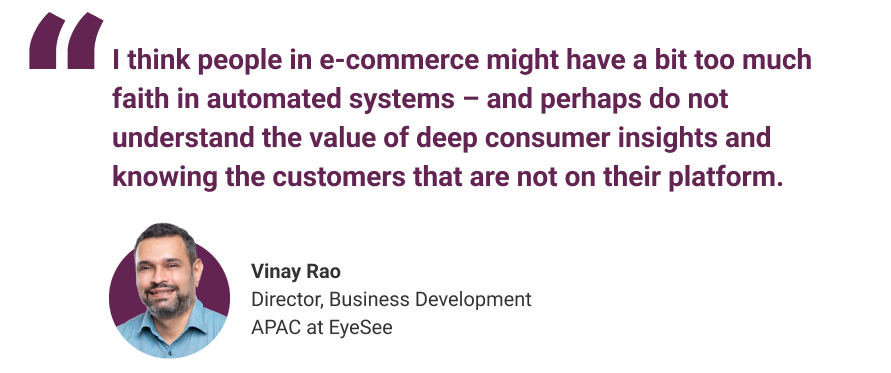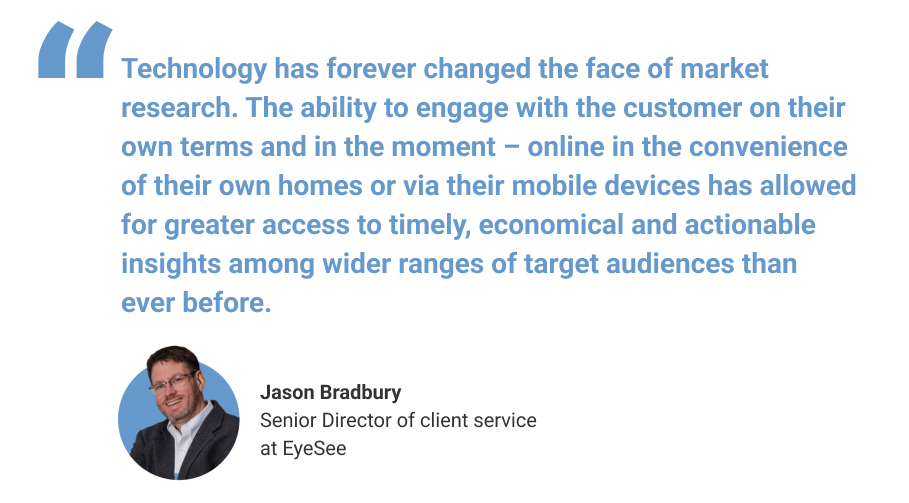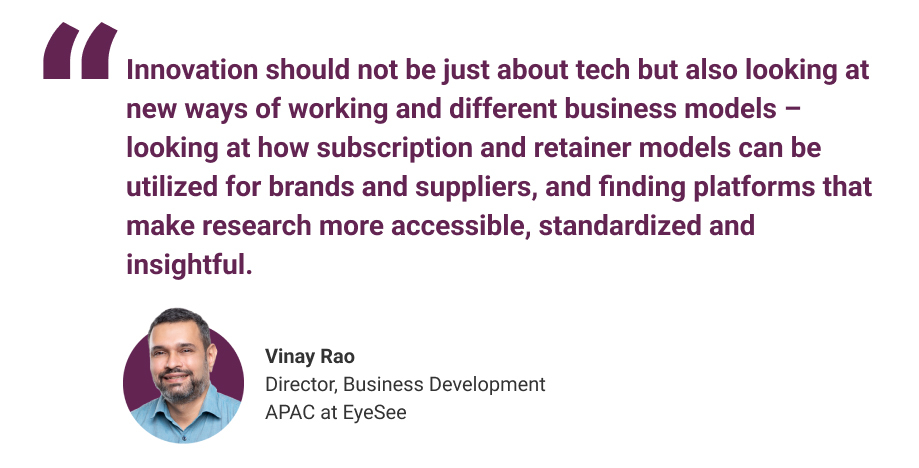What are some of the innovative ways brands have been supporting consumers during difficult times like economic crises? Which markets and sectors have been benefiting from behavioral research and which ones are still missing out on it? How is tech changing the future of MR and is it really the key to successful innovation – both for brands and research suppliers? To answer these burning questions, we sat down with our new yet seasoned experts, Jason Bradbury (Senior Director of Client Service, EyeSee) and Vinay Rao (Director, Business Development APAC) and picked their brains on the current (and future) market research landscape. With their vast expertise covering the US, and the APAC markets, respectfully, we wanted to dive deep into the differences and opportunities each one has.
Yes, brands are doing a lot to support consumers – but you can do more
When talking about the different ways companies and brands have been helping their consumers under these inflationary pressures, Vinay stated that there had been innovative examples of leading brands in the APAC region, such as Lazada, who are paving the way in supporting consumers. Even tech giants like Apple are coming up with ways to ease this transitionary period for their users by introducing various payment plans. However, in Vinay’s opinion more opportunities for retailers lie in teaming up with e-commerce platforms to identify spaces where they can truly align and tap into the consumers’ current needs to drive growth.

As Jason explained, historically, brands that have been active in promoting social change, community and tackling global issues were able to build more solid connections with their consumers – which in turn, reassured shoppers of their brand choices and provided them with new reasons to continue to support them despite potential changes like price increases. Furthermore, he noted, the state of the current economy presents a moment of “reappraisal” where shoppers reconsider how and where to spend their money. For many brands, this disruptive moment might push more shoppers towards Private Labels due to the lower price points – which only emphasizes the need for leading brands to create added value for their products even more. That’s where innovating comes in – either as introducing new products to market or going beyond the product and connecting with shoppers over bigger issues that create a sense of collaboration and partnership.
Luxury and digital are actually lagging behind FMCG
Both Vinay and Jason agreed that behavioral MR has had an undoubtable impact on the FMCG industry – with the virtual shopping environments empowering brands to accurately measure key performance indicators of product visibility, navigation, emotional connection, and sales potential with a remote and scalable approach. For Jason, the manner in which the shopper engages in mainstream FMCG products – either physically in store or in digital marketplaces is generally consistent across retailers and relatively easy to produce – thus making measuring consumer behavior in these areas reliable.
On the other hand, and maybe paradoxical, one domain Vinay believes is missing out on the fruits of behavioral research is, in fact, e-commerce. His perspective is that tech such as eye tracking and click tracking uncovering how users interact with e-comm platforms – and, more importantly, how they make purchase decisions can go a long way for many e-tailers.

A few more areas that Jason acknowledges could benefit from behavioral, contextual research: products that have longer purchase cycles – such as, home fixtures, furniture, automotive, etc., and luxury or high-end consumer goods. But as research technology continues to transform and these categories become easier to engage with, more opportunities will arise for behavioral-driven insights to guide marketing decision-making.
The true way to democratize MR is driven to embrace novel tech
From Vinay’s perspective, tech is transforming research in 2 major ways – firstly, the visualization of the shopping experience and that realism that brands typically try to achieve through surveys. With the simulated retail stores, websites and social media feeds, brands can obtain a more predictive response by putting consumers in environments that feel real to them. Another way tech is elevating research is its accessibility – it is faster and more cost-effective. Even reporting has evolved, through dashboards and various platforms, allowing a more nuanced look into the consumer insights.

The strength of consumer insights that are derived from these immersive testing environments is something Jason finds the most exciting. The more realistic stimuli presentation and truer system-1 focused performance assessments, he notes, are ultimately narrowing the divide between traditional question-and-answer research and that which can be captured from observing actual real-life consumer behavior.
You must rethink innovation and everything it encompasses
As Jason stated, innovation must be based on creating benefits and added value for the end-user – both for brands and research suppliers. While brands must focus on enriching the consumer experience through meaningful product enhancements, features and benefits, suppliers’ mission should be to ensure that their solutions yield in-depth insights on how shoppers engage with brands and products. This will result in improved decision-making power, give enhanced agility to the end-user, and allow research professionals to better support their clients via deeper partnership and delivery of relevant thought leadership.

The key to successful innovation, however, in not relying solely on technology – taking a step back and looking at the entire ecosystem of a business and THEN using tech to fill the gaps that were not possible in the past. Companies should allocate some research budgets to explore new and innovative methods and do so consistently until they become a part of the culture and their KPIs. But what is also crucial at the moment and will be in the upcoming months is the resilience of a business both in terms of economic uncertainties and sustainability – so brands must focus their innovation efforts on that as well.
Interested in how to stay on top of the recession? Check out our series on the ongoing crisis and the fresh study findings on different pricing strategies!
 Jason Bradbury is the Senior Director of client service at EyeSee and a highly seasoned research professional of 30 years. He partnered with many Fortune 500 firms on marketing communications and shopper insights engagements.
Jason Bradbury is the Senior Director of client service at EyeSee and a highly seasoned research professional of 30 years. He partnered with many Fortune 500 firms on marketing communications and shopper insights engagements.
 Vinay Rao is New Business Development Director at EyeSee with a broad experience in the Market research industry across four countries in APAC and with various methodologies in shopper, innovation, and brand research.
Vinay Rao is New Business Development Director at EyeSee with a broad experience in the Market research industry across four countries in APAC and with various methodologies in shopper, innovation, and brand research.
